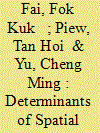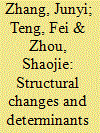| Srl | Item |
| 1 |
ID:
160546


|
|
|
|
|
| Summary/Abstract |
Highly skilled diasporas are increasingly being recognized as valuable transnational resources for the economic development of their respective home countries. This study investigates the macro-level forces that have driven the spatial distribution of the highly skilled diasporas of five ASEAN countries, namely Indonesia, Malaysia, the Philippines, Singapore and Thailand. In this paper, seemingly unrelated regressions (SUR) are developed, based on the augmented gravity model of migration. The findings reveal that diaspora stocks, market size, and development level in the destination country are significant determinants. To benefit from the heterogeneity of diasporic resources, the ASEAN-5 countries should establish collaborative mechanisms to mobilize their collective pool of diasporas for economic development.
|
|
|
|
|
|
|
|
|
|
|
|
|
|
|
|
| 2 |
ID:
176649


|
|
|
|
|
| Summary/Abstract |
Understanding the energy use and choice behaviors in urban China is essential to curb its energy consumption and air pollutant emissions. Current energy consumption estimates for urban households in China rarely account for the effects of building types on energy choice behavior, thus may lead to biased policy implications. In this paper, we estimate the determinants of household energy consumption for different energy choice scenarios through the Seemingly Unrelated Regression (SUR) model, using urban household data. The empirical results show that household use of various energy carriers is driven by household income, fuel price, demographics, building attributes and lifestyles. Results show building types have a significant effect on household energy consumption behaviors. Households living in old houses have less access to clean energy, such as piped gas. Income and price elasticities of energy consumption vary with energy type in each scenario, and there exist certain substitution effects among different types of energy carriers. In particular, inter-fuel substitute elasticities between coal and clean energy are asymmetric. Our study highlights the significance of city planning and infrastructure expansion policies and also offers a better basis for coordinating and designing energy policies in urban China and other developing countries.
|
|
|
|
|
|
|
|
|
|
|
|
|
|
|
|